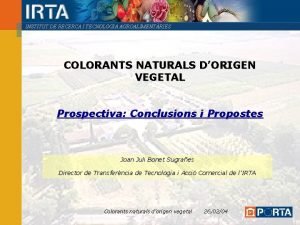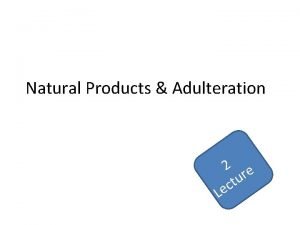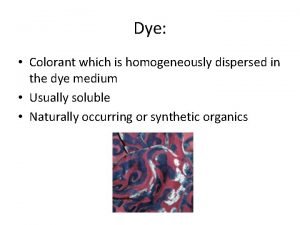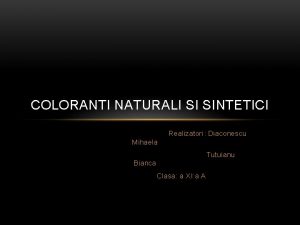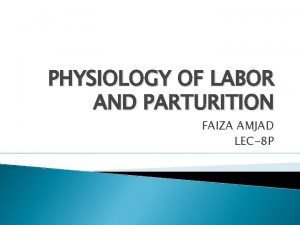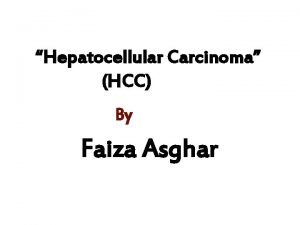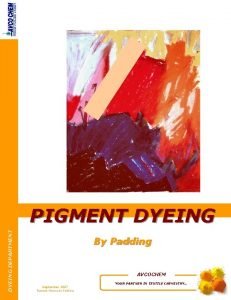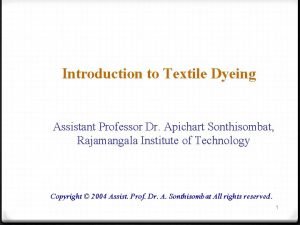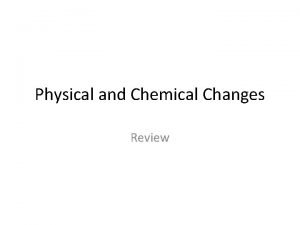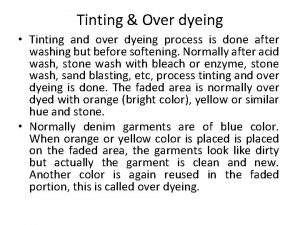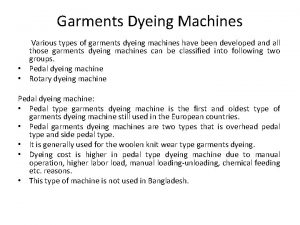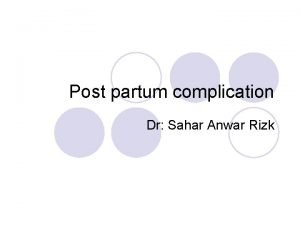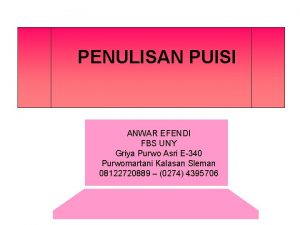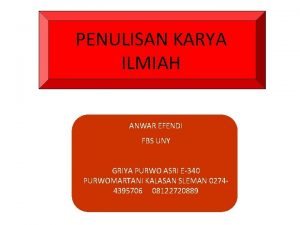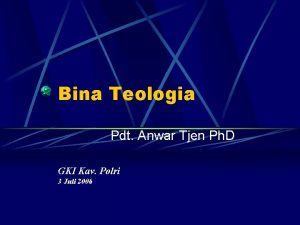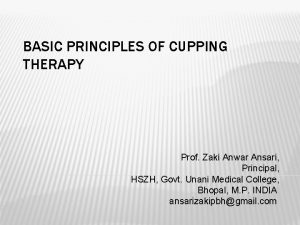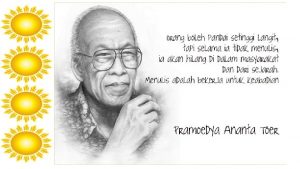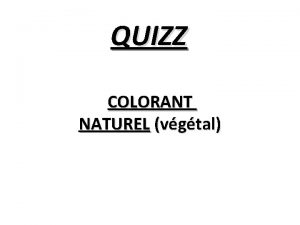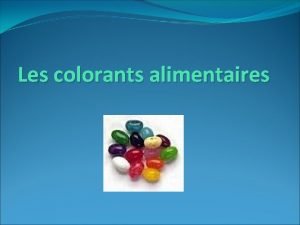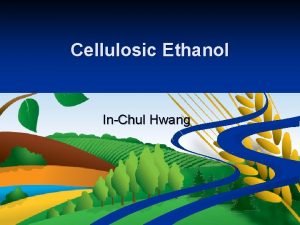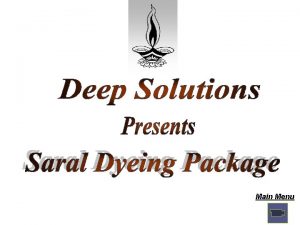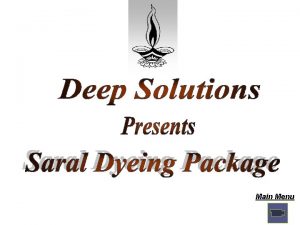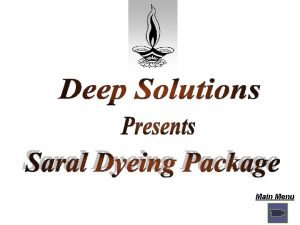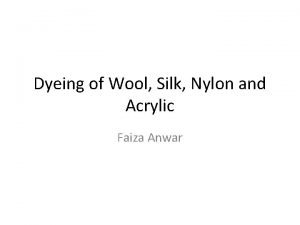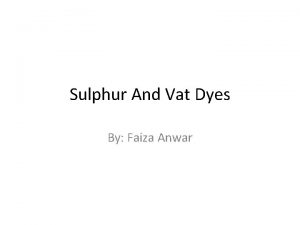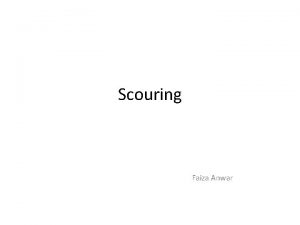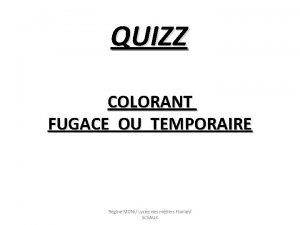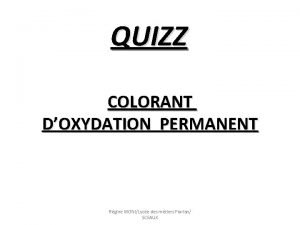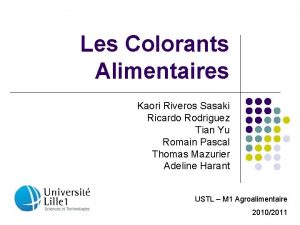Cellulosic Dyeing FAIZA ANWAR Colorants A colorant is
































- Slides: 32

Cellulosic Dyeing FAIZA ANWAR

Colorants • A colorant is a substance capable of imparting colour to a given substrate, such as paper or cotton, in which it is present • Not all colorants are dyes • A dye must be – – – Soluble Substantive Absorbable (at fiber level) • Pigments are colorants composed of particles that are – – – Insoluble not substantive Pigment particles are large and do not penetrate into fiber

Dyes �The four major characteristics of dyes are: intense colour solubility in water at some point during the dyeing cycle some substantivity for the fibre being dyed reasonable fastness properties of the dyeing produced.

Classification of dyes For Cotton and other Cellulosics � Direct Dyes � Reactive Dyes � Vat Dyes � Sulfur Dyes For Wool, Silk, Nylon and other Protein Based � Acid Dyes For Acrylic � Basic Dyes For Polyester � Disperse Dyes

Basic Parts of a Dye Molecule • Basic Parts – Chromophores – Auxochromes – In chromophore, Chroma a greek word, means color and phore is taken from pherein means to bear. – Organic molecules containing on any one chromophore becomes colored. – In auxochromes, auxein means to increase. – They increase intensity of color, solubility of dyes and Colorfastness properties.

Chromophores • Azo Group • Triaryl Methane Group • Nitroso Group • Quinonoid Group • Nitro Group

Auxochromes �They also intensify the color. �Additionally act as solubilizing agents b/c of polarity. �Improve the color fastness (due to polarity). �Hydroxyl group, �Amino Group, �Substituted Amino �Sulfonic acid group, -SO 3 H, or �Carboxylic acid group, -COOH, or more usually, the sodium salt of these acids, -SO 3 -Na+ and -COO-Na+, respectively.

Theory of Direct Dyeing • Exhaustion – Proportion of dye taken up by the fiber at any stage of the process relative to the amount originally available. • Substantivity – The attraction of a dye for a given substrate • Fixation – Proportion of dye remaining on the fiber at the end of the process relative to the amount originally available • Fastness – Resistance to fading due to washing, light, or any other color influencing agent. etc

Direct Dyes � Direct dyes are simply applied from their aqueous liquor in which electrolyte is added, Na. Cl. � Sodium Chloride dissociates into Na+ and Cl-. � As the cotton fiber is also – negatively charged, Na+ is attached onto fiber. � First it neutralizes and then creates a layer of positive charges by Sodium Cation. � Cl- in liquor then pushes dye anion and the dye attaches itself onto fabric. � Direct dyes attach with fiber by hydrogen bonding or vander waals forces (weaker bonds).

Hydrogen bond �A hydrogen bond is the electrostatic attraction between polar molecules that occurs when a hydrogen (H) atom bound to a highly electronegative atom such as nitrogen (N), oxygen (O) or fluorine (F) experiences attraction to some other nearby highly electronegative atom. �A hydrogen bond tends to be stronger than van der Waals forces, but weaker than covalent bonds or ionic bonds.

Hydrogen bond � Hydrogen accord bonding between the hydroxy groups of cellulose and centres of electronegativity (nitrogen, oxygen and sulphur atoms) in the dye molecule, especially those substituted with hydrogen atoms (as in =N–NH–, –NH 2, –CONH–, –OH and –SH), is widely acknowledged to contribute to adsorption and retention of the dye molecules. � Hydrogen bonding is possible for almost any cellulosic hydroxy group in the amorphous regions of the fibre. � The more hydrogen bonds that a dye can form with the glucosidic polymer, the more readily it can compete with and rupture the fibre–fibre hydrogen bonds in order to penetrate more deeply into the amorphous structure of the polymer

Behavior of Dye Molecule in Dyebath • Stages of Dyeing – Adsorption: The first stage in dyeing cellulosic fibres with direct dyes is initial uptake of the dye on the fibre surface, known as strike. – Absorption: The second stage is diffusion of the dye into the fibre to approach an equilibrium distribution of dye between fibre and dyebath. – Fixation or retention: attachment of the dye to the fiber by means of any bonding.

• Adsorption, takes place due to repulsive forces (water) and attractive forces (fiber) – Depends on ionic nature of dye • Important factors affecting the absorption of direct dyes by cellulosic fibres include • • time and temperature of dyeing, liquor ratio, salt concentration, and the solubility and aggregation behaviour of individual dyes.

Interaction of Dye Molecule with fiber �Textile fibers are organic compounds and develop a slight negative surface charge. �As the dye molecule and fiber both are negatively charged, the dye and fiber are repelled by each other. �Solutions Addition of Electrolyte, Increase in the temperature of dye bath.

Interaction of Dye Molecule with Water � Water is a medium for dyeing (transport dye and temperature) � Dye has affinity both for water and fiber. � Dye molecule attracts water due to polarity. � This attraction has to be overcomed. � This can be accomplished by heating which makes water molecules to colloid with eachother and with the dye molecules resulting in transfer and penetration of dye molecule inside polymer system of fiber. � Water assisted by heat, swells the fiber, making the polymer more accessible to dye molecule.

Effect of Electrolytes � Direct dyes are applied to cellulosic fibres in the presence of an electrolyte at or near the boil the addition of electrolyte to a solution of direct dye tends to lower the electrostatic repulsion between the negatively charged dye anions and promote aggregation, the effect of the presence of an inorganic salt when dyeing cellulose is to overcome the long-range forces of repulsion between the dye anions and the negatively charged fibre surface. � The closer approach then allows hydrogen bonding and other short-range attractive forces to operate between the dye molecules and the glucoside units of the fibrous polymer.

Effect of Electrolytes � Sodium Chloride dissociates into Na+ and Cl-. � As the cotton fiber is also –vely cahrged, Na+ is attached onto fiber. � First it neutralizes and then creates a layer of positive charges by Sodium Cation. � Cl- in liquor then pushes dye anion and the dye attaches itself onto fabric.

Effect of Temperature • Absorption of dye or penetration inside fibre are temperature- dependent and are accelerated by an increase in temperature. • An increase in the temperature of dyeing raises the rate of dye absorption. • Increases the molecular energy of the system. • Decreases aggregation of dyes. • Increases dye penetration into the fiber. • Swells the fiber thus resulting in better entrapped molecules on cooling. When the system is cooled, and fibers dried, the polymer system will close up, thus trapping the dye molecule

Influence of auxiliaries on dye sorption �The effect of anionic and nonionic surfactants on the state of aggregation of direct dyes in solution has been studied. Nonionic agents tend to inhibit the formation of larger aggregates and increase the proportion of dye in the monomolecular form. �Solubilisation of direct dyes by nonionic agents proceeds effectively up to the critical micelle concentration of the surfactant. �Thus concentrated solutions of direct dyes can be stabilised using nonionic additives but the absorption of the dyes by cellulose is decreased when nonionic agents are present.

Effect of Time and Liquor ratio � The production of level and well penetrated dyeing is favoured by an increase in the time of dyeing. � Dye bath exhaustion is highly dependent on liquor ratio, but other factors such as � solubility, � levelling properties and � strike have to be taken into account.

THE AFTERTREATMENT OF DYEINGS WITH DIRECT DYES � Aftertreatment of dyeings of direct dyes on cellulosic materials aims to improve the washing fastness by increasing the dye’s molecular weight. � This makes it less soluble in water. � Some of these processes decrease the light fastness of the dyeing. � Aftertreatments are difficult and costly to carry out, and often give changes in hue that greatly impede shade correction and colour matching. � Many of the direct dye aftertreatments now have limited use because reactive dyes give dyeings of much better washing fastness.

�Formaldehyde treatment �Copper sulfate treatment �Are two examples of after-treatments

Reactive Dyes �They are so called because they make a chemical reaction to fiber and make Covalent bond. �Covalent bond is the sign of strength. �The dyestuff thus becomes a part of the fiber and are not removed by washing as compared the dyestuffs that adhere by adsorption.

Reactive Dyes The chromogen is as mentioned before (azo, carbonyl or phthalocyanine class). The water solubilising group (ionic groups, often sulphonate salts), which has the expected effect of improving the solubility, since reactive dyes must be in solution for application to fibres. The bridging group links the chromogen and the fibrereactive group. Frequently the bridging group is an amino, -NH-, group. This is usually for convenience rather than for any specific purpose. The fibre-reactive group is the only part of the molecule able to react with the fibre. Like: Aromatic rings, Alkenes

Reactive Dyes � Mostly used for cellulosic fibers. � Very Good color Fastness properties. � Contains functional group that react with OH group in fibre. � Make covalent bond. � May also react with water (in that case it is said to be hydrolyzed; opposite case is termed as fixed dye)/ � Alkali is added to increase the reactivity of Oxygen atom on cellulose thus increasing its affinity to react with electron deficient reactive group on dye.

Cellulosic Dyeing with Reactive Dyes �Dye liquor is prepared similar to direct dye liquor. �Reactive dye is dissolved in water and an electrolyte is added to it for exhaustion of the dye onto the surface of the textile material as it is introduced to the dye liquor. �For the reaction between dye and cellulosic textile material, alkali must be added to the dye liquor.

Cellulosic Dyeing with Reactive Dyes �For some dyes this reaction take place at room temperatures and for some dyes the temperatures must be increased (in some cases to the boil). �As a result the covalent bond is formed between the reactive dye molecule and the hydroxyl groups of the cellulosic fiber.

Effect of Salt and Alkali �Increase in p. H increases The ionization of OH group in cellulose thus increasing its affinity for electron deficient reactive group thus facilitates the formation of covalent bond. Ph influence primarily the concentration of the cellusate site on the fiber. The reaction of dye with water resulting in hydrolyzed dye.

�Effect of Alkali: Different types of alkali Na. OH , soda ash, sodium silicate or a combination of these alkalis are use in order to attain the required dyeing PH.

Effect of Acids and Chlorine �The covalent bond of reactive dyes with fiber is formed under alkaline conditions and it will be broken if the conditions become acidic for example by perspiration and pollution. �Chlorine bleaches also degrade reactive dyes however some chlorine resistant reactive dyes have also been synthesized.

Color Fastness Properties of Reactive Dyes �W. F of reactive dyes is very good, having rating of 4. �This is because they have very stable electronic arrangement in bond formed between dye and fiber. �L. F of reactive dyes are good to very good, having blue wool scale rating of about 6. This is due to very stable electronic arrangement in their chromophores. �Washing Off is essential to remove the hydrolysed dye from fiber.

References �Textile SCIENCE BY: E. P. G. GOHL
 Types of desizing methods
Types of desizing methods Colorants naturals
Colorants naturals Experience de l'amidon dans le pain
Experience de l'amidon dans le pain Name two adulterants of cardamom
Name two adulterants of cardamom Color 09282001
Color 09282001 Obtinerea colorantilor
Obtinerea colorantilor Faiza amjad
Faiza amjad Pemra cable tv licence fee
Pemra cable tv licence fee Features of the victorian novel
Features of the victorian novel Faiza asghar
Faiza asghar Faiza bhatti
Faiza bhatti Hyperparathyroidism
Hyperparathyroidism Naima akef
Naima akef Pigment dyeing process
Pigment dyeing process Printing and dyeing assistant
Printing and dyeing assistant Is crumple physical or chemical change
Is crumple physical or chemical change Over dyeing
Over dyeing Garment dyeing machine
Garment dyeing machine Sahar anwar
Sahar anwar Post doc betyder
Post doc betyder Growth development and maturation
Growth development and maturation Saiful anwar general hospital
Saiful anwar general hospital Annisa anwar
Annisa anwar Anwar efendi uny
Anwar efendi uny Kristine kousholt
Kristine kousholt Anwar efendi uny
Anwar efendi uny Cmsc 411
Cmsc 411 Dr ayesha anwar
Dr ayesha anwar Anwar tjen
Anwar tjen Carotenmia
Carotenmia Zaki anwar body
Zaki anwar body Anwar efendi uny
Anwar efendi uny Jelaskan struktur fisik dan struktur batin dalam puisi
Jelaskan struktur fisik dan struktur batin dalam puisi

